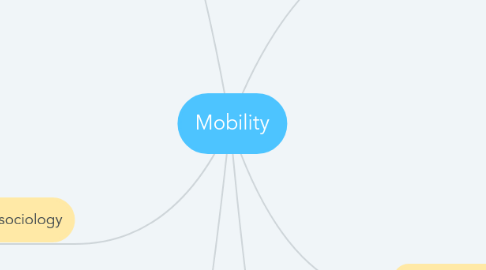
1. Mobility and Design
1.1. Natural factors in design
1.1.1. Time limitation
1.1.2. Don't design for mobile, design for mobility
1.2. Possible mistakes
1.2.1. The ignorance of practicability
1.2.2. Complex design process may influence the final result
1.3. Design thinking for mobility
1.3.1. Advices
1.3.2. Tools
1.3.3. Process
2. Mobility and sociology
2.1. Concept
2.1.1. Social mobility refers to the movement of individuals, families, or groups among stratified social positions
2.1.1.1. Related articles
2.2. Methodology
2.2.1. quantitative sociology
2.2.2. qualitative research
2.3. Type of Social Mobility
2.3.1. Horizontal Social Mobility
2.3.1.1. Horizontal mobility one of the types of mobility, is the straight change from left to right or right to left.
2.3.2. Vertical Social Mobility
2.3.2.1. Vertical mobility refers to the change in status of an individual as moves up or down the social ladder. For example, the manager of the meat department who is promoted to general manager of the supermarket has achieved upward vertical mobility.
2.3.3. Intergenerational Social Mobility
2.3.3.1. Intergenerational mobility refers to social mobility that takes place between generations. When the daughter of a taxicab driver earns a college education and goes on to become a successful medical doctor, intergenerational mobility has occurred.
2.3.4. Intra-generational Social Mobility
2.3.4.1. Intra-generational mobility refers to a change or changes in the social status of an individual or group of individuals within the same generation.
2.3.5. Territorial Social Mobility
2.3.5.1. Territorial social mobility is the change in locality, territory or resistance when an individual move from one place to another place is called territorial mobility.
3. Mobility in literature and culture
3.1. Reasons for the close relationship
3.1.1. world-historical processes like migration and the slave trade to local mobilities of travel, translation and transplantation
3.1.2. narrative shaping of individual life trajectories in the bildungsroman, personal and social forms of mobility
3.2. socio-economic evidence from UK government
4. History of Urban Mobility
4.1. Civilization has closely been related to mobility of human activities
4.1.1. City has been a engine of economic prosperity and center of innovation in the history
4.1.2. City has been and an essential ingredient for modernization
4.2. Mobility in Cities
4.2.1. Revolution in city mobility
4.2.1.1. first revolution introduced by the steam powered technology
4.2.1.2. second revolution enabled by the emergence of the automobile and highways
4.2.1.3. third revolution with digitalization started with emergence of computer-aided travelling
4.2.2. Innovation in transportation led the first and second revolution of urban mobility
4.3. Modernization of Seoul : history that overcame barriers of mobility
4.3.1. First period : Rapid expansion but insufficient mobility(1950s – 1970s)
4.3.2. Second period : Achieving mobility with infrastructures (1980s – 1990s)
4.3.3. Third period : Upgrading mobility through the ICT(2000s)
5. Geographic mobility
5.1. Definition
5.1.1. Geographic mobility is the measure of how populations and goods move over time. Geographic mobility, population mobility, or more simply mobility is also a statistic that measures migration within a population.
5.2. The contributes of geography to mobility
5.3. Geography and the Politics of Mobility
6. The Psychology of Global Mobility
6.1. The history of human beings is the history of global mobility
6.2. Psychological mobility and career success
6.2.1. Organizational mobility negatively affected promotions, job and career satisfaction.
6.2.2. Boundaryless mindset related positively to wage and promotions.
6.2.3. Boundaryless mindset impacted career success via functional mobility.
6.2.4. The effect of mobility preference was mediated by organizational mobility.
6.3. The Effects of Culture on Psychological Mobility
6.3.1. the effects of culture on psychological mobility has two major implications for future research
6.3.1.1. First, the result of high vertical individualism in Turkish sample should be refined whether it is because the measurement problem of INDCOL or high power distance in collectivist cultures.
6.3.1.2. Second, this survey has just conducted on academicians who worked in big and developed cities of both countries, it will be useful to extend similar research in different regions, professions and sectors.
